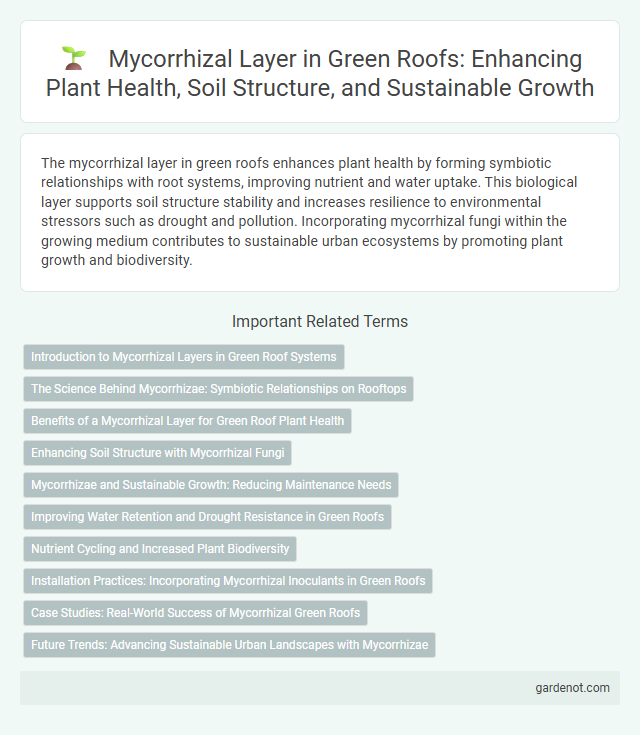The mycorrhizal layer in green roofs enhances plant health by forming symbiotic relationships with root systems, improving nutrient and water uptake. This biological layer supports soil structure stability and increases resilience to environmental stressors such as drought and pollution. Incorporating mycorrhizal fungi within the growing medium contributes to sustainable urban ecosystems by promoting plant growth and biodiversity.
Introduction to Mycorrhizal Layers in Green Roof Systems
Mycorrhizal layers in green roof systems enhance plant health by establishing symbiotic relationships between fungi and plant roots, improving nutrient and water uptake. These fungal networks increase soil stability and promote biodiversity within the green roof substrate. Incorporating mycorrhizal inoculants during installation optimizes plant growth and resilience against environmental stressors.
The Science Behind Mycorrhizae: Symbiotic Relationships on Rooftops
Mycorrhizal fungi form symbiotic relationships with plant roots, enhancing nutrient and water absorption critical for green roof vegetation. These fungi improve soil structure and increase drought resistance by extending the root system through microscopic hyphae. Scientific studies demonstrate that incorporating a mycorrhizal layer in green roofs boosts plant health, growth rates, and overall ecosystem resilience in urban environments.
Benefits of a Mycorrhizal Layer for Green Roof Plant Health
A mycorrhizal layer enhances green roof plant health by improving nutrient uptake, particularly phosphorus and nitrogen, essential for vigorous growth. This symbiotic fungal network increases water retention in the substrate, reducing plant stress during drought conditions. Enhanced root development from the mycorrhizal association also stabilizes plants, promoting resilience and long-term sustainability of green roof ecosystems.
Enhancing Soil Structure with Mycorrhizal Fungi
Mycorrhizal fungi significantly improve soil structure in green roofs by forming extensive hyphal networks that bind soil particles, increasing porosity and water retention. This enhanced soil aggregation supports root growth and nutrient uptake, essential for plant health in the limited substrate of green roofs. Incorporating a mycorrhizal layer promotes sustainable green roof ecosystems through improved soil stability and resilience to environmental stress.
Mycorrhizae and Sustainable Growth: Reducing Maintenance Needs
Mycorrhizae form a symbiotic mycorrhizal layer within green roofs that enhances plant nutrient uptake and water absorption, promoting sustainable growth. This natural biological network reduces the need for frequent watering and chemical fertilizers, lowering overall maintenance requirements. Integrating mycorrhizal fungi supports resilient vegetation, improves soil health, and fosters long-term eco-friendly green roof ecosystems.
Improving Water Retention and Drought Resistance in Green Roofs
The mycorrhizal layer in green roofs enhances water retention by forming symbiotic relationships with plant roots, increasing soil moisture absorption and storage capacity. This fungal network improves drought resistance by facilitating efficient nutrient and water exchange, allowing plants to withstand prolonged dry periods. Integrating mycorrhizal fungi into green roof substrates supports sustainable stormwater management and promotes healthier, more resilient rooftop vegetation.
Nutrient Cycling and Increased Plant Biodiversity
The mycorrhizal layer in green roofs enhances nutrient cycling by facilitating the exchange of essential nutrients such as phosphorus and nitrogen between soil and plant roots, leading to improved plant health and growth. This symbiotic relationship supports increased plant biodiversity by enabling a wider variety of native and drought-tolerant species to thrive under urban environmental stresses. Enhanced microbial activity within the mycorrhizal network promotes soil fertility and resilience, directly contributing to sustainable green roof ecosystems.
Installation Practices: Incorporating Mycorrhizal Inoculants in Green Roofs
Incorporating mycorrhizal inoculants during green roof installation enhances plant nutrient uptake and stress resilience by establishing symbiotic fungal networks within the substrate. Optimal practices include evenly distributing mycorrhizal spores throughout the growing medium before planting to ensure effective root colonization. Proper moisture management and substrate composition support fungal establishment, promoting long-term green roof viability and ecological benefits.
Case Studies: Real-World Success of Mycorrhizal Green Roofs
Case studies demonstrate that integrating a mycorrhizal layer in green roofs significantly enhances plant health and drought resistance by improving nutrient uptake and soil structure. Research from urban environments reveals increased biodiversity and reduced maintenance costs, confirming the mycorrhizal symbiosis as a key factor in successful green roof ecosystems. These findings support broader adoption of mycorrhizal inoculation to optimize green roof performance and sustainability.
Future Trends: Advancing Sustainable Urban Landscapes with Mycorrhizae
Mycorrhizal layers in green roofs enhance plant nutrient uptake and improve soil structure, promoting healthier urban ecosystems. Future trends focus on integrating advanced mycorrhizal inoculants to boost drought resistance and carbon sequestration in city environments. Research aims to optimize symbiotic fungi interactions, driving sustainable urban landscapes and reducing ecological footprints.
Mycorrhizal layer Infographic

 gardenot.com
gardenot.com